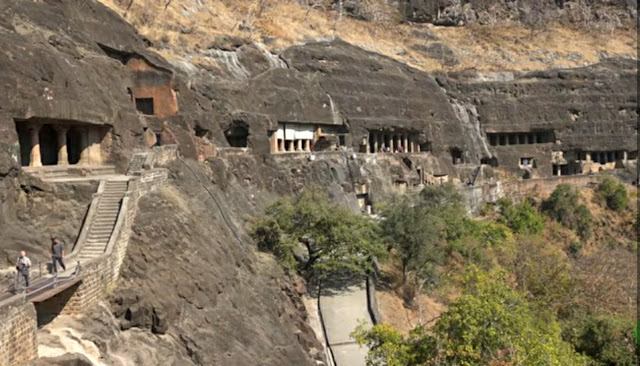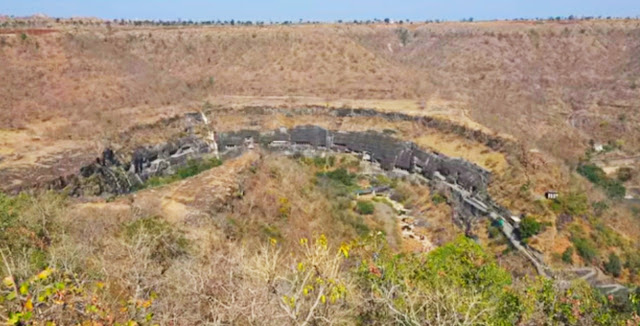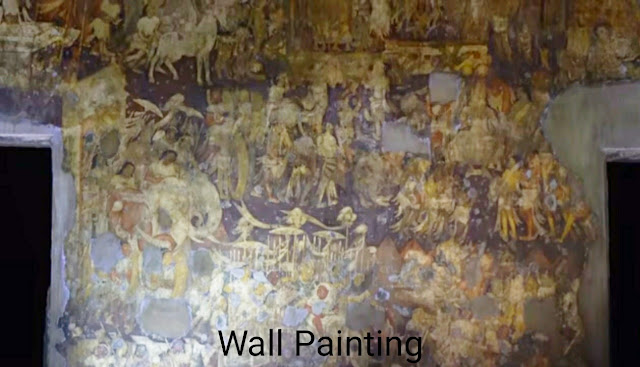अजंता की गुफाएं
अजंता लगभग 30 से अधिक रॉक-कट बौद्ध गुफा स्मारकों के लिए विश्व भर में प्रसिद्ध हैं। यह गुफाएं भारत के महाराष्ट्र राज्य के औरंगाबाद जिले में स्थित है जो कि दूसरी शताब्दी ईसा पूर्व से लेकर लगभग 480 ई.पू. तक की हैं।
 |
| Ajanta caves (अजंता की गुफाएं) |
अजंता की गुफाओं में दिवारों पर वर्णित चित्रकारीता और रॉक-कट मूर्तियां शामिल हैं। यूनेस्को के अनुसार, ये बौद्ध धार्मिक कला की उत्कृष्ट कृतियाँ हैं जिन्होंने भारतीय कला को प्रभावित किया। गुफाओं को दो चरणों में बनाया गया था, पुराने खोजों के अनुसार पहला चरण दूसरी शताब्दी ईसा पूर्व के आसपास शुरू हुआ था, जबकि दूसरा चरण 400-650 सीई के आसपास बनाया गया था, नए खोज के अनुसार दुसरा चरण 460-480 सीई के बीच में हुआ था। यह स्थल भारतीय पुरातत्व सर्वेक्षण की देखभाल में एक संरक्षित स्मारक हैं और यूनेस्को की विश्व धरोहर स्थल भी हैं।
अजंता गुफाओं की वास्तु शैली
अजंता की गुफाओं का निर्माण दो चरणों में किया गया था। पहले चरण के गुफाओं का निर्माण सातवाहन वंश के राजाओं ने किया था जबकि दूसरे चरण की गुफाएं वाकाटक वंश के राजा हरीसेना द्वारा किया गया था। अजंता की गुफाओं में प्राचीन मठों और विभिन्न बौद्ध परंपराओं के पूजा-मंडप का निर्माण किया गया हैं, जो 75 मीटर (246 फीट) की चट्टान की दीवार में खुदी हुई हैं। गुफाओं में बुद्ध के पिछले जीवन और पुनर्जन्म, आर्यसुर के जटाकमाला से चित्रात्मक कहानियों और बौद्ध देवताओं की रॉक-कट मूर्तियों को चित्रित करते हुए चित्र भी मौजूद हैं। शाब्दिक रिकॉर्ड से पता चलता है कि इन गुफाओं में भिक्षुओं के लिए मानसून पीछे हटने के साथ-साथ प्राचीन भारत में व्यापारियों और तीर्थयात्रियों के लिए एक विश्राम स्थल के रूप में कार्य किया गया था। जबकि भारतीय इतिहास में ज्वलंत रंग और भित्ति-चित्र बहुतायत में थे, जैसा कि ऐतिहासिक अभिलेखों से पता चलता है, अजंता की गुफाएं 16, 17, 1 और 2 प्राचीन भारतीय दीवार-चित्रकला में जीवित रहने का सबसे बड़ा कोष हैं।
 |
| Ajanta caves (अजंता की गुफाएं) |
अजंता की गुफाओं का ऐतिहासिक महत्व
अजंता की गुफाओं का उल्लेख भारत में कई मध्यकालीन युग के चीनी बौद्ध यात्रियों के संस्मरणों में और 17 वीं शताब्दी की शुरुआत में अकबर युग के एक मुगल-युग के अधिकारी द्वारा किया गया है। अजंता की गुफाएं मध्ययुगीन काल के बाद से लंबे समय तक जंगल से कवर किए गए थे। 1819 में एक बाघ-शिकार पार्टी में एक औपनिवेशिक ब्रिटिश अधिकारी कप्तान जॉन स्मिथ द्वारा इन गुफाओं की गलती से खोज हुई और इन गुफाओं को पश्चिमी ध्यान में लाया गया। गुफाएँ वाघुर नदी के यू-आकार के कण्ठ की चट्टानी उत्तरी दीवार में हैं, घाट के भीतर कई झरने हैं, जो नदी के ऊँचे होने पर गुफाओं के बाहर से श्रव्य है।
चित्रकला
 |
| Ajanta caves (अजंता की गुफाएं) |
अजंता की गुफाओं में चित्रकारी मुख्य रूप से जातक कथाओं का वर्णन करती है। ये बुद्ध के पिछले जन्मों का वर्णन करने वाली बौद्ध किंवदंतियाँ हैं। ये दंतकथाओं में प्राचीन नैतिकताएं और सांस्कृतिक झोल हैं जो हिंदू और जैन ग्रंथों की दंत कथाओं और किंवदंतियों में पाए जाते हैं। जातक कथाओं को जीवन उदाहरण और बलिदानों के माध्यम से समझा जाता है कि बुद्ध ने अपने सैकड़ों पूर्व अवतारों में बनाया, जहां उन्हें एक जानवर या मानव के रूप में पुनर्जन्म होने के रूप में चित्रित किया गया है।
पर्यटन
एलोरा गुफाओं के साथ, अजंता की गुफाएं महाराष्ट्र के प्रमुख पर्यटक आकर्षणों में से एक है। यह फ़रदापुर से लगभग 6 किलोमीटर, जलगाँव शहर से 59 किकिलोमीट, औरंगाबाद शहर से 104 किलोमीटर और मुंबई से 350 किलोमीटर पूर्व-उत्तर-पूर्व में स्थित है। अजंता से 100 कीमी की दूरी पर एलोरा की गुफाएं हैं, जिसमें हिंदू, जैन और बौद्ध गुफाएं हैं, जो अजंता के समकालीन है। अजंता शैली एलोरा गुफाओं और अन्य स्थानों जैसे कि एलिफेंट गुफाओं, औरंगाबाद गुफाओं, शिवलीनी गुफाओं और कर्नाटक के गुफा मंदिरों में भी पाई जाती है।
 |
| Ajanta caves (अजंता की गुफाएं) |
---------------- -------------- ------------- --------------- -------------- ------------- ---------------
English Version
Ajanta Caves
Ajanta is famous worldwide for more than 30 rock-cut Buddhist cave monuments. These caves are located in Aurangabad district of Maharashtra state of India from the second century BCE to about 480 BC. Ajanta caves are one of the best tourist places in India.
 |
| Ajanta caves (अजंता की गुफाएं) |
The Ajanta caves contain paintings and rock-cut sculptures described on the walls. According to UNESCO, these are masterpieces of Buddhist religious art that influenced Indian art. The caves were built in two phases, according to older discoveries the first phase began around the second century BCE, while the second phase was built around 400–650 CE, according to the new discovery the second phase was between 460–480 CE. The site is a protected monument under the care of the Archaeological Survey of India and is also a UNESCO World Heritage Site.
Architectural style of Ajanta caves
The Ajanta caves were constructed in two phases. The caves of the first phase were built by the kings of the Satavahana dynasty while the caves of the second phase were built by King Harisena of the Vakataka dynasty. The caves of Ajanta have built ancient monasteries and worship halls of various Buddhist traditions, carved into a 75 m (246 ft) rock wall. The caves also feature paintings depicting Buddha's past life and rebirth, pictorial stories from Aryasura's Jatakamala and rock-cut sculptures of Buddhist deities. The literal record suggests that these caves served as monsoon retreats for monks as well as a resting place for merchants and pilgrims in ancient India. While vivid colors and frescoes were in abundance in Indian history, as historical records reveal, Ajanta caves 16, 17, 1 and 2 are the largest treasures of survival in ancient Indian wall-painting.
 |
| Ajanta caves (अजंता की गुफाएं) |
Historical Significance of Ajanta caves
The Ajanta caves are mentioned in the memoirs of many medieval Chinese Buddhist travelers in India and by a Mughal-era official of the Akbar era in the early 17th century. The caves of Ajanta were covered with forest for a long time since the medieval period. In 1819, these caves were accidentally discovered by Captain John Smith, a colonial British officer at a tiger-hunting party, and these caves were brought to Western attention. The caves are in the rocky northern wall of the U-shaped gorge of the Waghur River, there are several waterfalls within the ghat, which is audible from outside the caves when the river is high.
The paintings in Ajanta caves
 |
| Ajanta caves (अजंता की गुफाएं) |
The paintings in Ajanta caves mainly narrate the Jataka tales. These are Buddhist legends describing past lives of Buddha. These legends contain ancient morals and cultural beliefs found in the legends and legends of Hindu and Jain texts. The Jataka tales are understood through life examples and sacrifices that Buddha made in his hundreds of earlier incarnations, where he is depicted as being reborn as an animal or a human.
Tourism
Along with Ellora caves, Ajanta caves are one of the major tourist destination in India. It is located about 6 km from Faradapur, 59 km from Jalgaon city, 104 km from Aurangabad city and 350 km east-north-east from Mumbai. At 100 km from Ajanta, thet are Ellora caves, which contain Hindu, Jain and Buddhist caves, which are contemporary to Ajanta. The Ajanta style is also found in Ellora caves and other places such as Elephant caves, Aurangabad caves, Shivlini caves and cave temples in Karnataka.
 |
| Ajanta caves (अजंता की गुफाएं) |





it's amazing and most beautiful caves in India. Thanks for sharing these post.
ReplyDeleteJim Corbett Resorts Packages | Jim Corbett Safari | Corbett Resorts